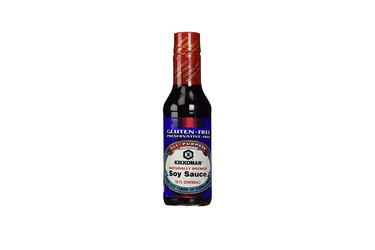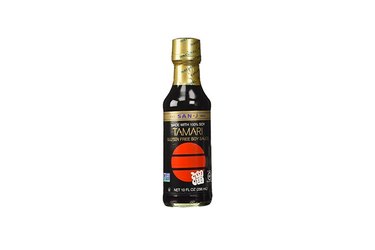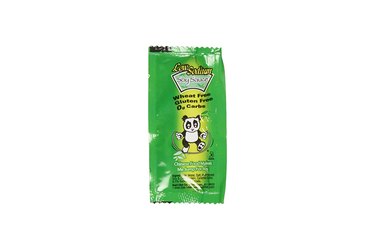
A colorful roll of sushi or a steaming bowl of ramen isn't the same without soy sauce. But if you have celiac disease, you're sensitive to gluten or you're just trying to eliminate it from your diet, you'll want to be careful: The beloved liquid condiment isn't gluten-free.
You've got choices, though: If you're cooking at home you could try swapping soy for other, similar ingredients or you can keep things simple and buy gluten-free soy sauce instead.
Video of the Day
Video of the Day
Read more: 9 Foods You Didn't Know Contain Gluten
Why Is Gluten in Soy Sauce to Begin With?
Most commonly used to flavor meat or rice in Asian cuisines, soy sauce typically follows a pretty simple ingredient list: soybeans, wheat, water and salt.
Soybeans are legumes and naturally free of gluten, which is a protein found in wheat, rye and barley. It's the wheat that's added to soy sauce that's the problem for people who are sensitive to or cannot eat gluten. Soy sauce makers use wheat to add sweetness to the mix, as well as to build the condiment's trademark aroma, according to manufacturer Kikkoman.
If you're sensitive to gluten, you may want to consider some of the gluten-free soy sauce options on the market. These varieties are usually made with rice instead of wheat, explains Vandana Sheth, RDN. They're also nearly identical to standard soy, she adds. The taste, consistency and appearance are all very similar, and even when it comes to expiration and shelf life, both regular and gluten-free soy sauces match up.
Read more: Side Effects of Starting a Gluten-Free Diet
Picking Gluten-Free Soy Sauce
There are several factors to consider when purchasing gluten-free soy sauce at the store. Sheth recommends that you always check the ingredient list for wheat, even if you've been using the same brand and bottle for a long time. Brands may not change the look of their bottles, but the formula could have been altered, she says.
Keep sodium in mind when you're shopping, too. Soy sauce is known for its salty flavor and packs about 879 milligrams of sodium per tablespoon, according to the USDA. This makes quite a dent in the American Heart Association's recommended limit of 2,300 milligrams per day. If you're concerned about how much sodium you're eating, dip with caution or look for a low-sodium version of your favorite soy sauce.
If you prefer to skip soy sauce entirely, Sheth suggests some gluten-free alternatives that make for easy substitutions:
- Tamari, a popular wheat-free swap made with miso paste that has a richer flavor than standard soy sauce
- Liquid aminos, a soybean-derived liquid protein concentrate with a bolder flavor than soy
- Coconut aminos, a sauce made from coconut tree sap
- Bouillon cube
- Rice vinegar
- Dried mushrooms, for a similar umami flavor
If you're highly sensitive to gluten or have celiac disease, consider bringing your own gluten-free soy sauce to a sushi restaurant. If you're eating somewhere that serves both regular and gluten-free condiments, there is always a threat of cross-contamination. A restaurant may not wash their bottles carefully or they may mix up the sauces. It's better to play it safe, Sheth says.
The Best Gluten-Free Soy Sauces and Alternatives
1. Kikkoman Gluten-Free Soy Sauce
Kikkoman's gluten-free soy sauce has a short, preservative-free ingredient list, brewed with only water, soybeans, rice and salt. This option is deemed gluten-free by the Gluten Intolerance Group of North America, a certification program that inspects products and manufacturing facilities for gluten.
Buy it: Amazon.com; Price: $8.49
2. San-J Tamari Gluten-Free Soy Sauce
San-J's tamari sauce is gluten-free, made with 100% soy and no wheat. Like Kikkoman's variety, San-J's tamari has a short ingredient list, formulated with only water, soybeans, salt and alcohol (which is used to preserve freshness).
Buy it: Amazon.com; Price: $8.09
3. Kari-Out Low-Sodium Soy Sauce Gluten-Free
If you're looking for a convenient option to take on-the-go, Kari-Out sells a case of 400 individual gluten-free soy sauce packets. Although they are wheat-free and easy to carry to a restaurant, this pick has a longer ingredients list (that includes preservatives), generally a tipoff that you're dealing with a highly processed food.
Buy it: Amazon.com; Price: $17.25
4. Coconut Secret Coconut Aminos

Coconut Secret's gluten-free soy sauce alternative can be used exactly like soy in dressings or with sushi. Coconut tree sap gives this option a tangy and sweet flavor with less sodium than traditional soy sauce. This version has only two ingredients: coconut tree sap and sea salt. Coconut Secret's coconut aminos are also USDA-certified organic and certified gluten-free.
Buy it: Amazon.com; Price: $14.51
5. Bragg Liquid Aminos

Bragg's liquid aminos are made with protein from soybeans. This brand is gluten-free as well as free of chemicals, artificial coloring and alcohol.
Buy it: Amazon.com; Price: $24.71
Read more: Nori-Wrapped Avocado


